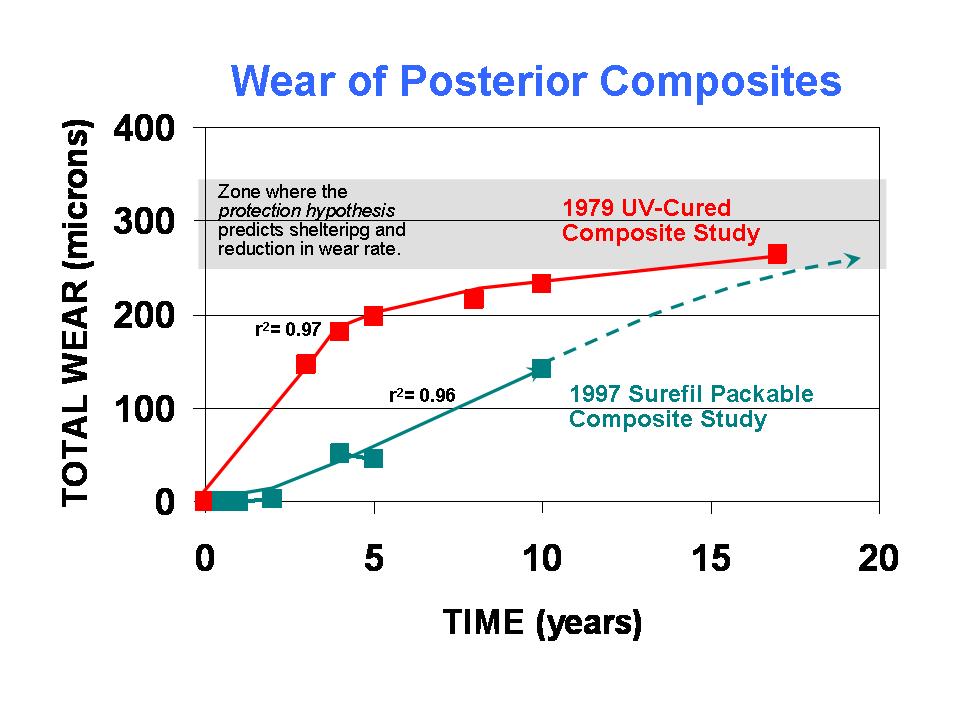 |
 |
 |
 |
10-Year Clinical Performance of Packable Posterior Composite
|
A.D. WILDER, Jr.1, S.C. BAYNE2, H. HEYMANN1, J. PERDIGAO3, and E.J. SWIFT, Jr.1, 1University of North Carolina, Chapel Hill, USA, 2University of Michigan, Ann Arbor, USA, 3University of Minnesota, Minneapolis, USA | Click on images to view full size. Introduction: Early laboratory testing suggested poor wear resistance for some packable composites versus traditional hybrids.
Objective: Evaluate 10y clinical performance of a promising packable composite versus ADA-4y guidelines (1989) for acceptance of “unrestricted” amalgam-replacement materials and linearly-extrapolated 10y-ADA guidelines.
Methods: 60 packable composite restorations (20% Class-I; 80% Class-II) originally were placed in 30 patients (62% women; 65% 1st-molars and 35% 2nd-molars; mean age = 42y) as large preparations (FL width ³⅓ intercuspal distance; no bevels) with normal techniques (local anesthesia; rubber dam). Enamel and dentin were total-etched (15s of 34%-H3PO4; 10s rinse), bonded (P&B-2.1 [Dentsply]), and restored (SureFil [Dentsply], 1997). Wear was rated (Leinfelder method; 6m baseline-subtracted) and analyzed (ANOVA, a=0.05, see superscripts). Cumulative failures (%F) for restorations and individual modified-USPHS categories for color match (cm), marginal discoloration (md), secondary caries (sc), marginal integrity (mi), interproximal contact (ic), and post-op sensitivity (ps) were tallied and compared to linearly-extrapolated (=2.5X) 10y-ADA guidelines.
Results: 10y results passed both 4y and 10y guidelines. Wear increased from 5y-to-10y (p=0.0001), showed strong linear regression with time (r2=0.96, see figure), had not yet leveled off, but was low (~14 µm/y).
| | Cumulative Failures (%F) | | Pts | Rests | Wear (µm±sd) | Restorations | cm | md | sc | mi | ic | ps | ADA-4y | 20 | --- | ≤100 | ≤10% | ≤10% | ≤15% | ≤5% | ≤10% | ≤10% | --- | ADA-10y | --- | --- | ≤250 | ≤25% | ≤25% | ≤38% | ≤12% | ≤25% | ≤25% | --- | UNC-0y | 30 | 60 | ----- | 0% (n=0/60) | 0% | 0% | 0% | 0% | 0% | 0% | UNC-2y | 28 | 53 | 5±18a (n=45) | 4% (n=2/53) | 0% | 0% | 0% | 0% | 0% | 4% | UNC-4y | 26 | 44 | 52±30b (n=44) | 7% (n=1/44) | 0% | 0% | 2% | 0% | 0% | 4% | UNC-5y | 21 | 37 | 46±41b (n=37) | 9% (n=1/40) | 0% | 3% | 5% | 3% | 3% | 5% | UNC-10y | 11 | 17 | 142±71c (n=17) | 9% (n=0/17) | 0% | 3% | 5% | 6% | 6% | 5% | Conclusion: This packable composite demonstrated excellent clinical performance and passed all guidelines.
Acknowledgment: Supported by Dentsply-Caulk.
| | Seq #54 - Clinical Performance of Resin Composite Restorations
10:45 AM-12:15 PM, Thursday, July 3, 2008
Metro Toronto Convention Centre Room 801B |
|
Back to the Dental Materials 4: Clinical Trials, Biocompatibility and Biologic Effects Program
|
|
